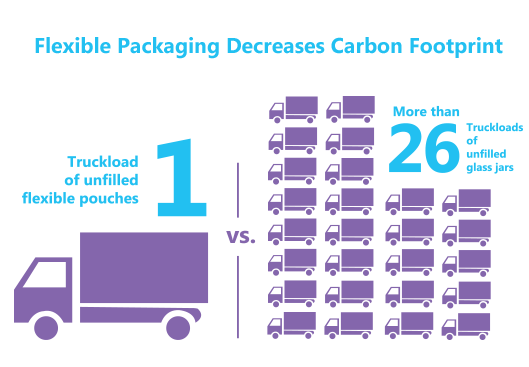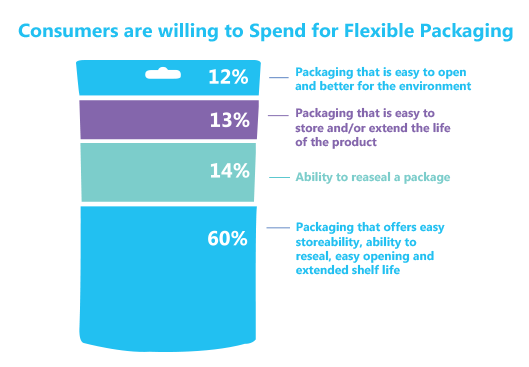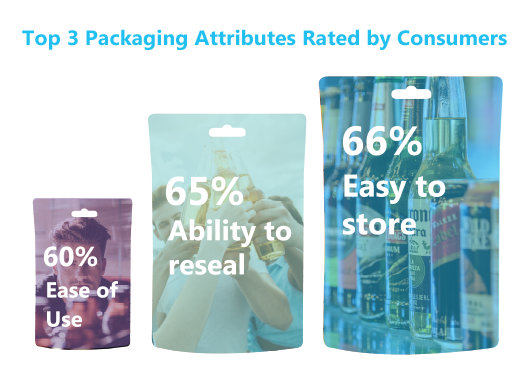Is your current package environmentally sustainable? Would Mother Nature approve?
The many decisions around packaging and transporting your brand can be maddening. It’s no cake walk! Here are just a few considerations:
- Your product’s packaging must catch the consumer’s eye to maximize sales – while minimizing expenses
- Your package should be convenient for consumers, so they can easily use (and reuse) your product
- And wouldn’t it be great if your packaging solution is environmentally friendly?
Good news: with so many flexible packaging options, you can package and transport your product to ensure you'll maximize sales, minimize expenses, enhance consumer convenience, AND get Mother Nature’s approval!
Flexible packaging is environmentally sustainable. Let’s look at 3 key facts.
If you're considering using flexible packaging for your brand – or you need data to convince your management team to switch to flexible packaging – then read on. The following facts and data points are truly compelling.
Fact #1 Flexible packaging requires fewer trucks for transit, which saves you a ton (pun intended!)

Light-weight flexible packaging requires much less space to transport than cumbersome, heavy glass and aluminum containers. When fewer trucks are required to transport your products, this directly translates to reduced transportation costs (great for your company) and reduced fuel use and emissions (great for the environment).
Another way to view this topic is by looking at the product-to-packaging ratio. Here’s an example from research conducted by the Flexible Packaging Association (FPA) for 24 ounces of raisins:
- A round paperboard canister with a plastic lid has a product-to-packaging ratio of 17:1
- A stand-up flexible pouch has a product-to-packaging ratio of 60:1!
Fact #2 Flexible packaging reduces energy use and greenhouse gas emissions
Over its life cycle, flexible packaging uses less energy and produces less CO2 emissions (according to FPA research). In particular, the manufacturing process requires fewer natural resources, especially when compared to aluminum and glass.
Here’s just one example showing how flexible packaging uses fewer resources, courtesy of the FPA. In order to package 60 pounds of beverage, you would need:
- Only 1.5 pounds of flexible packaging
- Or 3 pounds of aluminum
- Or 6 pounds of rigid PET
- Or a whopping 50 pounds of glass!
According to the FPA: “The life cycle of flexible packaging demonstrates many sustainable advantages. Flexible packaging starts with less waste in the first place, greatly reducing landfill discards. Flexible packaging manufacturers use fewer natural resources in the creation of their packaging, including reduced water and energy consumption, greenhouse gas emissions, and volatile organic compounds. Light-weight flexible packaging results in less transportation-related fuel consumption and environmental pollution.”
Fact #3 Flexible packaging extends the product’s shelf life and reduces food waste
If your product’s package is stamped with a “use by” date, then flexible packaging is a must! According to FPA research, flexible packages often double the product’s shelf life, which directly contributes to reducing food waste. In one example – fresh ground beef – flexible packaging increases shelf life from 3 days to 20 days!
As a manufacturer of perishable products, flexible packaging allows you to take advantage of various packaging processes to extend your product’s shelf life: modified atmosphere packaging, vacuum packaging, and active packaging. According to Wikipedia, “The modification process generally lowers the amount of oxygen in the head-space of the package. Oxygen can be replaced with nitrogen (a comparatively inert gas) or carbon dioxide.”
A key feature of flexible packages is the ability to reseal and reuse products. Consumers love this cost-saving, waste-reducing feature for all types of perishable products including:
- Cannabis
- Wine
- Beverages
- Fresh foods
- Pet food and treats
- Medicine and other pharmaceuticals
The bottom line: Flexible Pack lets you please Mother Nature AND your consumers.
Team with Flexible Pack for your brand’s packaging. It’s the environmentally friendly choice, since energy consumption during transportation – and the overall impact to the environment – is greatly reduced.



